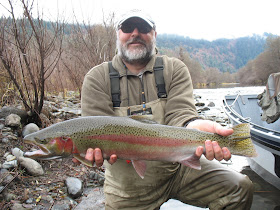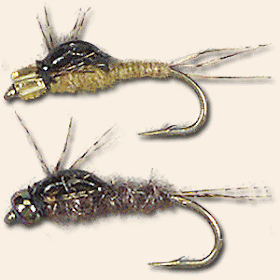 The Fall Lower Yuba Summary
The Fall Lower Yuba Summary
With the pounding we've taken prior to this Thanksgiving week, with snow storms knocking out power, breaking down oak and ornamental trees that still had leaves on them, I guess we can say winter has arrived. I'm sure we'll still see some Indian summer like days in December, but for all intents and purposes the fall is over and we need to look towards winter type conditions when heading out fishing. I thought I'd sort of sum up the 2010 fall fishing here on the Lower Yuba River.
The salmon came in early and in pretty big numbers, so the egg bite was pretty good. I made it out about once a week and so my experiences are based upon that. Some regular guides on the river have felt that it was one on the better fall seasons for the egg bite in a awhile. My experience was that it was a little tougher than last year, but like I said, I'm not out on the river everyday.
My conclusions after fishing the river pretty hard in the fall of 2009 and from this fall are as such.
- I believe that when the salmon are in the system and the resident rainbows are staged behind them, the best fishing happens early in the mornings before the sun really gets high. This is especially true when the water is low running at 900 cfs +/- and gin clear.
- The later the day gets and the more drift boats go down the tougher the fishing gets for fish staged behind the salmon and the river in general. First Down equals best fishing.
- It is my opinion that the fish move into deeper slots or more aerated water for sanctuary as the day gets brighter and with more fishing pressure.
- The above, I believe, holds true unless you get an overcast day. On overcast days the fishing can be consistent and the fish seem to be where you'd think they should be throughout the day.
- Troutbeads are the Bomb, especially if you steal nail polish from your wife or girlfriend, for the troutbeads.
- Don't forget about the bugs. The fish will still eat bugs, collect a sample, match the color and size of what you find, Stones, Caddis and Mayflies. Keep up good principles.
- Don't believe everything you hear at the fly shop, or from your buddies, do your sampling, look to the river to tell you what to do, experiment and keep trying!
Tight Lining
This year I've started stripping off the indicator more often and using less weight and using tight line nymphing techniques in the rollers and shallow runs up to four feet deep. I have more confidence in using straight line casting techniques in the rollers behind the salmon and keeping tight to the flies. Cast on top of the bucket or drop off, using enough shot to tumble the flies down into the bottom of the bucket. If there is not take, pick it up and recast to the next likely spot. This method is of course from a moving drift boat. Using this technique also works just as well when wet wading. Just don't wade in the redds!
When the depth of a run is 2 feet to 6 feet, you can also fish it effectively tight lining, just make sure you put on enough shot. The amount of shot is the key. We have consistently had success in these depths when tight lining, but you must feel the shot bouncing on the bottom from time to time. If not add a BB. If not add another BB. Get the picture.
We picked up the some of the biggest fish of the year using tight line methods in 2 foot or less deep water.
Indicator and Shot Method
I still like to put the indicator right back on as I work the deeper runs that have a consistent depth of 4 feet or more, This is more of a bug bite thing than an egg bite, although the numbers of fish caught using this method in the runs, the eggs still out perform the bug imitations throughout the fall. Dead drift them, mend properly, make sure you've got enough weight on. You've got to get and stay down.
If I don't take the indicator off when fishing tailouts or buckets, I'll straight line cast it and fish it tight line as if the indicator wasn't there, If you do this you have to pick it back up and re-cast to keep it fishing correctly. Sometimes I'll do this if there is a quick tailout or some redds with a deeper run right below it. This is really just being lazy but as you know it's easy to let happen. Theory is one thing.
Typical Rigging
My Fall standard rigg for indicator or tight line nymphing is;
(a) Start with a 3x, 7 1/2 or 9 foot foot leader
(b) Add 18" of 3x tippet and put shot above this knot
(c) Tie on an egg pattern of choice
(d) Add another 18" of 4x tippet tied to the hook bend of the egg and then tie on a bug of choice.
(e) Add another tippet of 5x tied to the hook bend of the 1st bug and then tie on another bug which is usually the smallest one.
The typical sequence goes egg, attractor nymph, usually a caddis, and then an imitative nymph at the end. I'd usually rigg both anglers starting with and egg, one with a Troutbead and one with a Pettis Egg, and 4 different nymphs. Then we'll switch it up if we've found out what the trout wants on any given day.
This leader works for tight lining or indicator nymphing. Just add a Thing-a-ma-bobber.
The Flies
As far as discussing flies, I'm considering the fall starting when the salmon first started showing up this year in August, these were the occasional springer salmon that are in the system. It really seems that as long as there are salmon around, even if they are spawned out or pre-spawning, the trout will eat and look for eggs, much earlier in the season than you might think. For the most part if we see a salmon, an egg goes on. Once an egg goes on in the fall season, it pretty much stays on the whole season in different types, sizes or colors. It's what a guide friend says, "It's Steak and Eggs Time".
The Troutbeads still were the best egg imitation, especially if you take the time to paint them with finger polish. I had good luck using Pettis Eggs early in the season, but the Troutbeads out performed everything for the middle and end of the fall.
In early fall we had real good luck with copper johns, and just about anything black, a black Copper John, Prince of Darkness, AP Black, Hogan's Yuba Pupa, Fox's Poopah, pretty much any standard caddis nymphs in olive etc. We had some exceptional fishing these bugs with an egg as a dropper in the tailouts above the Parks Bar Bridge.
We also had very good luck in the early fall with eggs and the above mentioned nymphs, in areas of the river where the river tailed up in run, from say 8 to 12 feet to 6 feet. The fish would sit right at the bottom of the up lift and be staged for nymphs moving toward the lifting gravel. They would take eggs and bugs about equally.
As the fall progressed we typically used a Troutbead, an olive caddis, and then a mayfly nymph. Pheasant Tails, Hogan's Military May's in Brown and Olive, Hogan's Yuba Pupa, Fox's poopahs in cinnamon and green. We had luck with a Spitfire one day which was a first for me.
When we found that the water was off colored from a recent rain storm we would go, Egg, Rubberleg Stone, and then a nymph of choice. We had some real good days when the visibility was about 4 feet or so. The off color provides a level of stealth that you just don't get with the spring creek clarity of the river flowing at 900 cfs +/-. When the river gets that off color look, try to get out there the fishing. The fishing can be great and typically brings up the adult steelhead, or resident rainbows, whoever's opinion as to what they are, you want to listen to. All I know is that, they are bigger and are fighters. We managed a few of these to the boat and lost some we never got a look at, but that's fishing.
All told, it was a great 2010 fall fishing season with friends, and many stories told, fish caught and lost. Although, as always, work always seems to keep me from getting out as often as I'd like. Maybe that won't be the case next year.
Have fun out there!


















































